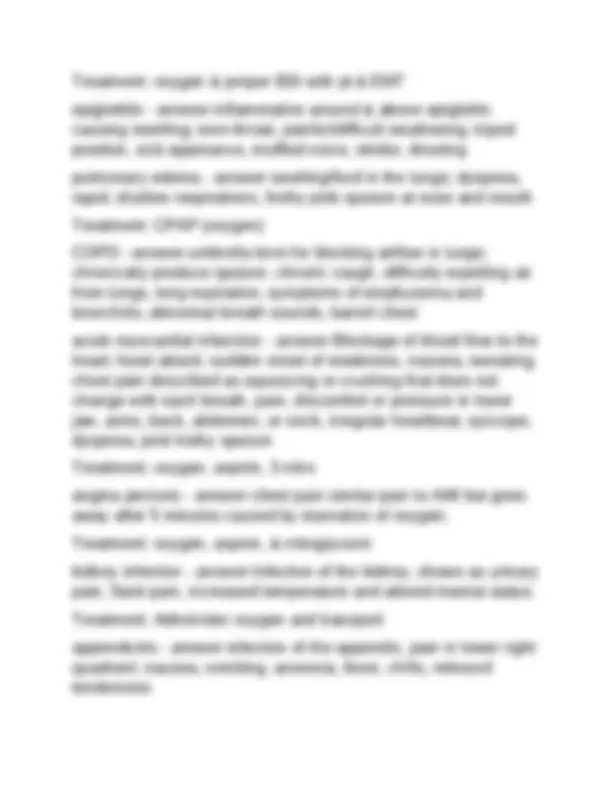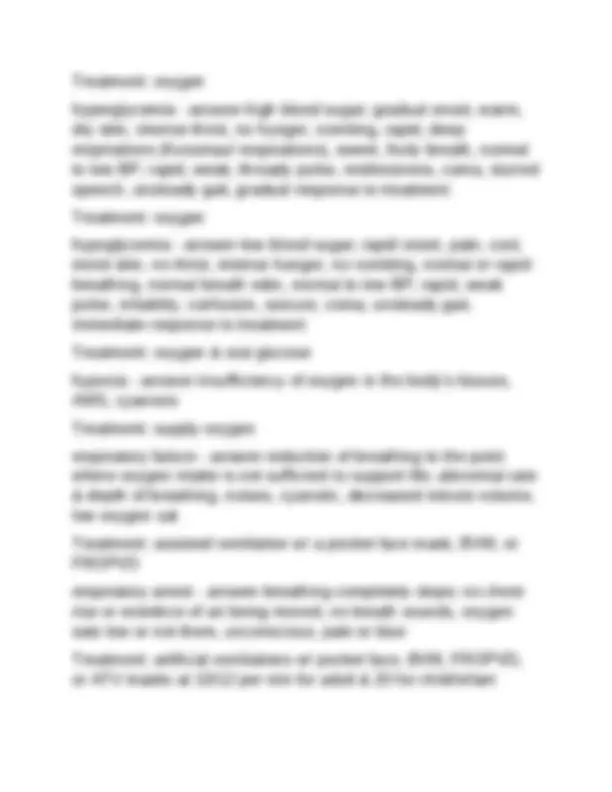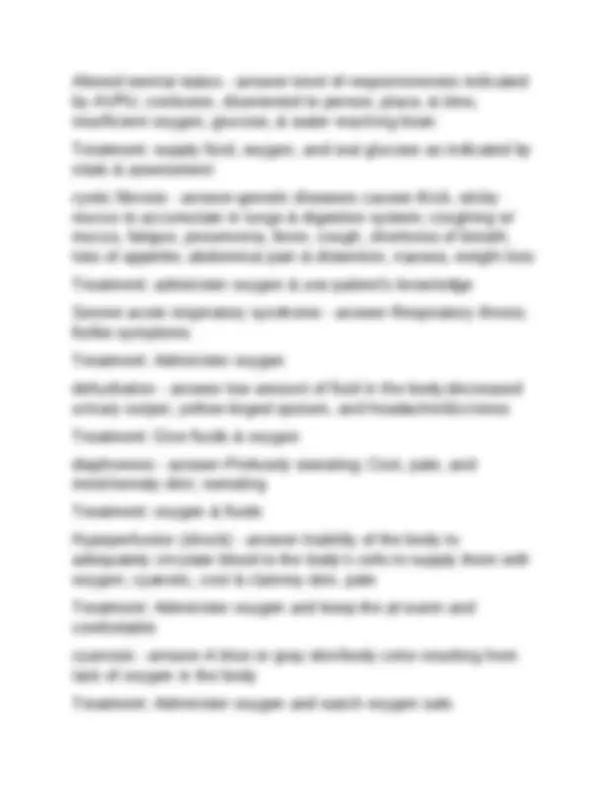






Study with the several resources on Docsity

Earn points by helping other students or get them with a premium plan


Prepare for your exams
Study with the several resources on Docsity

Earn points to download
Earn points by helping other students or get them with a premium plan
Community
Ask the community for help and clear up your study doubts
Discover the best universities in your country according to Docsity users
Free resources
Download our free guides on studying techniques, anxiety management strategies, and thesis advice from Docsity tutors
A comprehensive guide for emergency medical technicians (EMTs) on various medical conditions, their symptoms, treatments, and management strategies. It covers a wide range of diseases, including respiratory, cardiac, and metabolic disorders, as well as neurological and infectious conditions. The document aims to equip EMTs with the knowledge to recognize, assess, and manage these medical emergencies effectively in the field.
Typology: Exams
1 / 8

This page cannot be seen from the preview
Don't miss anything!





Asthma - answer-small airways constrict, wheezing on inspiration and expiration Treatment: Albuterol by small-volume nebulizer or inhaler, give oxygen anaphylaxis - answer-allergic reaction where blood vessels dilate (drop in BP & tissues in respiratory system swell): moderate to severe dyspnea, tightness in the chest, wheezing, muffled voice, stridor, generalized hives, pallor or flushed skin, swelling of facial area or injection site, tachycardia, hypotension, tachypnea, decreased oxygen saturation, feeling of impending doom Treatment: high-concentration oxygen, administer epinephrine auto-injectors bronchitis - answer-inflamation of bronchiole lining due to infection w/excess mucus, chronic/productive cough, wheezing, cyanosis, no fever, fluid in air passages, wheezing, ronchi, tachypnea Treatment: give oxygen congestive heart failure - answer-failure of the heart to pump right, excessive blood or fluid in lungs or body Edema, tachycardia, dyspnea, normal BP, cyanosis, diaphoresis, white or pink sputum, anxiety or confusion b/c hypoxia, jugular vein distention, enlarged liver or spleen Treatment: CPAP or high-concentration oxygen croup - answer-Viral illness, inflammation of larynx, trachea, & bronchi
fever, barking cough, mostly seen in pediatric, stridor, hoarseness, difficulty breathing, nasal flaring, retraction of rib muscles, restlessness, paleness with cyanosis Treatment: position of comfort, high-concentration oxygen (humidified) emphysema - answer-alveoli break down, reduce surface area for exchange & lose elasticity: barrel chest, pursed lip breathing, dyspnea on exertion, hypoxic drive, low oxygen levels Treatment: high-concentration oxygen pneumonia - answer-infection of lungs caused by bacteria, viruses, fungi. coughing, fever, chest pain, severe chills, shortness of breath, chest pain (pleuritic & sharp), confusion Treatment: oxygen or CPAP, albuterol inhaler if prescribed spontaneous pneumothorax - answer-lung collapses w/o injury & air leaks into thorax. sudden sharp chest pain, shortness of breathtire easily, tachycardiac, breathe fast, low oxygen sat, cyanosis Treatment: oxygen, auscultate lungs for diminished sounds pulmonary embolism - answer-clot, air or fat blocks an artery in the lung. sharp, pinpoint pain, dyspnea, anxiety, cough, sweaty skin, tachycardiacm tacypnea, dizzy, pain or swelling in legs, wheezing, hypotensive. Treatment: oxygen Tuberculosis - answer-Bacterial infection of the lungs; fever, coughing, fatigue, night sweats, weight loss, shortness of breath, productive sputum, bloody sputum, chest pain
Treatment: oxygen hyperglycemia - answer-high blood sugar; gradual onset, warm, dry skin, intense thirst, no hunger, vomiting, rapid, deep respirations (Kussmaul respirations), sweet, fruity breath, normal to low BP, rapid, weak, thready pulse, restlessness, coma, slurred speech, unsteady gait, gradual response to treatment Treatment: oxygen hypoglycemia - answer-low blood sugar; rapid onset, pale, cool, moist skin, no thirst, intense hunger, no vomiting, normal or rapid breathing, normal breath odor, normal to low BP, rapid, weak pulse, irritablity, confusion, seizure, coma, unsteady gait, immediate response to treatment Treatment: oxygen & oral glucose hypoxia - answer-insufficiency of oxygen in the body's tissues, AMS, cyanosis Treatment: supply oxygen respiratory failure - answer-reduction of breathing to the point where oxygen intake is not sufficient to support life; abnormal rate & depth of breathing, noises, cyanotic, decreased minute volume, low oxygen sat Treatment: assisted ventilation w/ a pocket face mask, BVM, or FROPVD respiratory arrest - answer-breathing completely stops; no chest rise or eviednce of air being moved, no breath sounds, oxygen sats low or not there, unconscious, pale or blue Treatment: artificial ventilations w/ pocket face, BVM, FROPVD, or ATV masks at 10/12 per min for adult & 20 for child/infant
Altered mental status - answer-level of responsiveness indicated by AVPU; confusion, disoriented to person, place, & time, insufficient oxygen, glucose, & water reaching brain Treatment: supply fluid, oxygen, and oral glucose as indicated by vitals & assessment cystic fibrosis - answer-genetic diseases causes thick, sticky mucus to accumulate in lungs & digestive system; coughing w/ mucus, fatigue, pneumonia, fever, cough, shortness of breath, loss of appetite, abdominal pain & distention, nausea, weight loss Treatment: administer oxygen & use patient's knowledge Severe acute respiratory syndrome - answer-Respiratory illness; flulike symptoms Treatment: Administer oxygen dehydration - answer-low amount of fluid in the body;decreased urinary output, yellow-tinged sputum, and headache/dizziness Treatment: Give fluids & oxygen diaphoresis - answer-Profusely sweating; Cool, pale, and most/sweaty skin; sweating Treatment: oxygen & fluids Hypoperfusion (shock) - answer-Inability of the body to adequately circulate blood to the body's cells to supply them with oxygen; cyanotic, cool & clammy skin, pale Treatment: Administer oxygen and keep the pt warm and comfortable cyanosis - answer-A blue or gray skin/body color resulting from lack of oxygen in the body Treatment: Administer oxygen and watch oxygen sats
diabetic ketoacidosis - answer-A condition that occurs as the result of high blood sugar; dehydration, altered mental status, and shock Treatment: oxygen Seizure - answer-A sudden change in sensation, behavior, or movement, shown as severely altered mental status, and in the worst cases, muscle convulsions, drooling Treatment: move objects from patient, wait, oxygen, suction Sepsis - answer-severe infection systemwide response; fever, difficulty breathing, low blood pressure, fast heart rate, and altered mental status Treatment: Administer oxygen stroke - answer-Caused when an artery in the brain is blocked or ruptured, shown as trouble speaking (slurring), paralysis and drooping of one side of the body, & AMS Treatment: oxygen & aspirin, Cincinnati scale Hives - answer-Red, itchy, possibly raised blotches on the skin Treatment: oxygen and epinephrine sickle cell anemia - answer-Disease in which patients have a genetic defect in their hemoglobin that results in an abnormal structure of the red blood cells; infection, pain, fatigue, and hypoxia Treatment: oxygen urinary tract infection - answer-An infection that begins in the urinary tract and ascends up the ureter into the kidney; lower back/flank pain, pain/discomfort/burning when urinating, altered mental status, high temperature
Treatment: oxygen